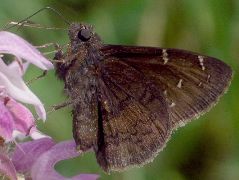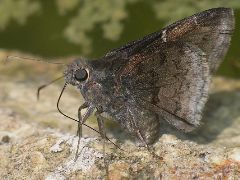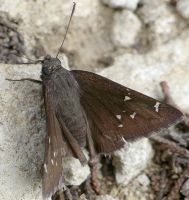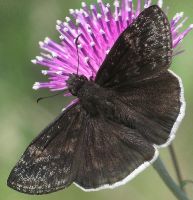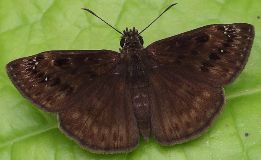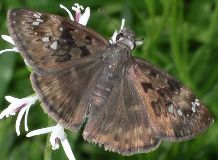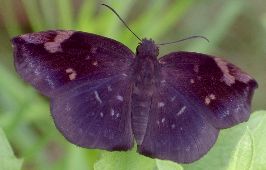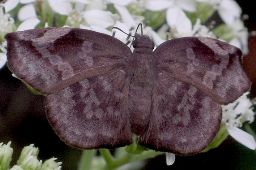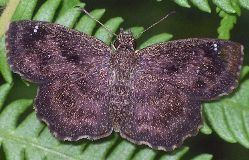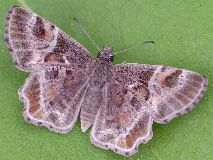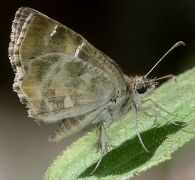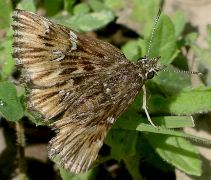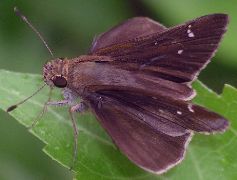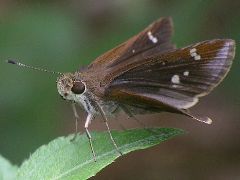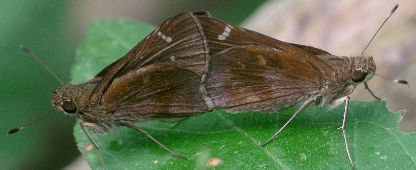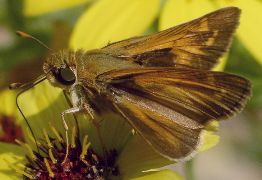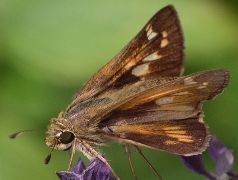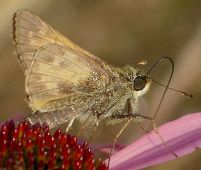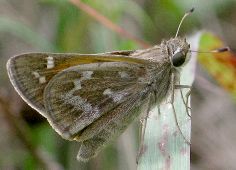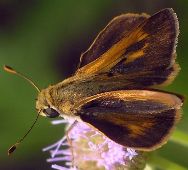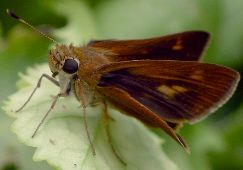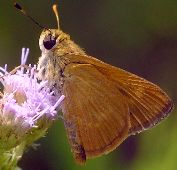
| Hesperiidae ~ Skippers |
|
A species of spread-wing skipper that doesn't really spread its wings when resting is the Northern Cloudywing (Thorybes pylades). When feeding or resting, this butterfly usually holds its wings at about a 45° angle, so that the tops of the wings are visible, but just barely. Sometimes they hold their wings closed. The Northern Cloudywing is rather large and bulky in appearance and very dark brown. It has just a few small white spots on the forewings. The undersides of the hind wing have markings that are only visible in certain light. Sometimes the outer third or so of the hind wings are frosted with silver but otherwise they are completely dark. This is supposedly a regional difference, with individuals from west Texas having more of the silver color but both forms are found here.
The duskywings are also rather chunky dark brown skippers, but they hold their wings out flat when resting. The Funereal Duskywing (Erynnis funeralis) is quite easy to recognize because of its white fringe on the hind wings. This often persists even in worn individuals.
Two more brown, and rather variable, duskywings occur here as well. Both the Juvenal's Duskywing (Erynnis juvenalis) and the Horace's Duskywing (Erynnis horatius) can be found in our area. However, the latter is much more common for a longer time. Juvenal's Duskywing is primarily an occasional spring and early summer visitor, while Horace's Duskywing is common through the autumn. The only reliable difference between the two is a pair of white spots on the underside of the hind wing on Juvenal's Duskywing. These dots are lacking on Horace's Duskywing. I have yet to get a good look at the underside of any duskywing so it is not a very useful marking. It is probably safe to assume that brown duskywings seen in the latter part of the year are Horace's Duskywing. The males are very dark with a few small white spots on the forewings, while the females tend to be marked the same way but on a lighter base and with larger white spots.
The Sickle-winged Skipper (Achylodes thraso) is a unique looking brown spread-wing. The wings do have an unusual shape to them, with an odd fold near the hooked forewing tips. The male is quite dark and velvety looking while the female has lighter markings. Another skipper with oddly shaped wings is the Hayhurst's Scallopwing (Staphylus hayhurstii). This small, dark brown spread-wing has an irregular edge to its hind wings and black and tan spotted fringes on all wings. Although the fringes can wear off, this is the only species that looks like this and occurs with any regularity in our area.
One other skipper has scalloped hind wings and that is the Texas Powdered-skipper (Systasea pulverulenta). About the same size and shape as Hayhurst's Scallopwing, it is a much lighter color, with lovely and complex markings of white and tan. I've often seen Powdered-skippers basking on leaves or on the ground. While they show up easily on a green leaf, they are almost invisible on gravelly soil. Although these butterflies rarely rest with their wings held up, I've seen what are probably males in a more agitated state, sort of dancing around on leaves, with their wings folded upwards. The odd thing about these is that their back legs have tufts of very long hairs, a feature I've never noticed on any other butterfly. Since some moths have extra hairs to help with pheromone dispersal, I would venture to guess that these tufts are a male trait that has to do with mating.
The last spread-wing skipper I'll mention is another that does not really spread its wings all that much. At least the one specimen that I've seen did not. The Common Streaky-skipper (Celotes nessus) is small and tends to fly low and erratically. The wings have a pleated appearance, with dark brown lines extending to the edges and making them look a bit ragged. If the spread-wing skippers seem a bit confusing to identify, the grass skippers can be absolutely frustrating. These butterflies tend to rest with their wings either folded up above their bodies or held at four different levels, with the forewings angled and the hind wings opened wider. This posture, which generally affords a view of the upper surfaces of one forewing and the opposite hind wing, is unique to the grass skippers. The group gets its name because the larvae feed on grasses.
The most commonly seen grass skipper in our area is the Clouded Skipper (Lerema accius). It is dark brown with a few white spots on the forewings. Females have larger white spots than males. The undersides of the wings are marked with purple frosted areas, best seen when the butterflies are fresh. One good clue to identification is a large vague brown band that extends diagonally across the underside of the hind wing, dividing the purplish areas.
Of several orange and brown skippers, the Sachem (Atalopedes campestris) is one of the most frequently seen. The females can be recognized by a very large glassy spot in the forewing, preceded by a dark marking on top. The underside of the hind wing sports a chevron of white squares pointing to the rear. The base color of the wing, though, ranges from very light tan to grayish brown. The males lack the glassy spot but have a prominent black mark in the forward center of their forewing. This is the stigma. The underside of the hind wing on males is generally more plain tan colored, with a noticeable dark area towards the bottom edge of the wing.
The Southern Broken-dash (Wallengrenia otho) is similar to the Sachem. However, it is more reddish orange in color, which helps distinguish it at a glance. The female has a pair of large orange spots in the center of the forewing, while the male's has a small orange slash next to a black mark and small black stigma on the upper side. Underneath, the hind wing has almost no markings except for a very faint large light mark shaped like a "3" facing towards the front of the butterfly. |
![]()
